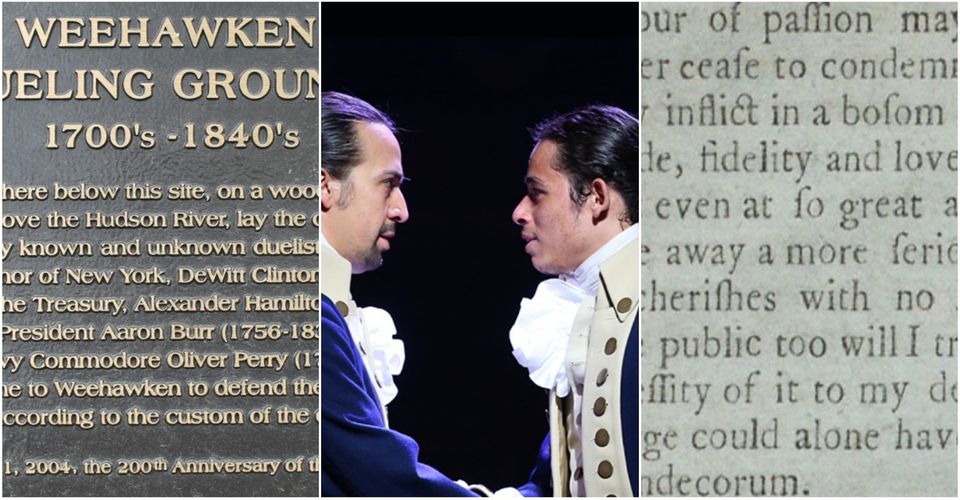Hamilton: 15 Hidden Details Everyone Completely Missed On Disney+

Anyone who has seen the hit musical Hamilton knows that it is one of the most layered and textured musicals of recent years, with both songs and characters that are easy to love (and sometimes to hate). This is, of course, largely due to the brilliance of its creator, Lin-Manuel Miranda, who manages to build so many subtle allusions and complexities into the play that one viewing isn’t enough to understand or appreciate them all.
Fortunately, the book Hamilton: The Revolution provides new details about the making of the play, allowing for a more nuanced appreciation of its genius and sophistication.
Updated by Theo Kogod on October 22nd, 2020: The musical Hamilton is that rare Broadway hit that comes once in a generation. Its appearance on Disney+ has allowed audiences to see it for the first time without having to pay for the price of theater tickets, but there is another reason that this play continues to grow in popularity. Lin-Manuel Miranda’s theatrical masterpiece about the foundation of American politics seems more relevant than ever as the United States 2020 Presidential Election gets ever closer.
15 The Two Battles in “The Farmer Refuted”

“The Farmer Refuted” is one of the earlier songs of the play and follows Hamilton’s struggles with the historical Samuel Seabury, a New Yorker loyal to the English crown who published numerous pro-English articles under the pseudonym A. W. Farmer.
Now only do Hamilton and Seabury battle out their ideological points, but the battle between their different musical styles is a separate layer to their tension. Seabury’s parts include older-sounding musical components with harpsichords, drums, and fifes, while the more revolutionary Hamilton spits out sick rap lyrics – new music for his new ideas.
14 The Set’s Architecture

Hamilton’s narrative takes place in numerous locations, including the streets of New York, the court of King George, and the heated pitch of battles. Obviously, theater techs could not possibly hope to build a single set for each location, but the crew did come up with an elegant solution.
During the Revolutionary period, New York was undergoing numerous building projects. The city also had a thriving shipbuilding industry. The sets used wooden architecture with rough-sawed beams evocative of the carpentry techniques used by shipwrights with coiled ropes further emphasizing the naval influences. Additionally, the chandeliers were inspired by the one in Fraunce’s Tavern in Lower Manhattan, the place where George Washington said goodbye to his officers – and a restaurant still open to the public today.
13 Hamilton Drops a Literal F-Bomb

The tensions between Hamilton and all of the other Founding Fathers is one of the central themes of the play. When Washington steps down from the Presidency, the play marks the election of John Adams with the song “The Adams Administration,” which is less about John Adams than it is about Hamilton getting sacked by Adams and overreacting.
When Adams insults Hamilton as a “Creole b****rd” in private, Hamilton very publicly responds in the press. On stage, Hamilton holds up a massive tome of papers and a quill, representing his published words, as he shouts, “Sit down, John, you fat motherf—!” Even as this is bleeped out, Hamilton drops the heavy stack of papers amid a whistle like a missile falling out of the sky.
12 Historical Authenticity

Every time the play could get history right, it did so. George Washington consults an exact copy of the map from Comte de Rochambeau that the historical general had at the Battle of Yorktown on parchment paper treated to resemble sheepskin.
Hamilton and Washington have personalized wax seals that are actually made of wax, while the wax candles are the real thing too. Whenever a newspaper is seen onstage, the paper is a recreation of a real New York-newspaper from the month it appears in the story. This is a level of detail the real Hamilton would approve of.
11 How Characters Walk

Aaron Burr and Alexander Hamilton are ideological opposites. They begin as friends, then become rivals, and finally, end up as enemies. While Hamilton is a revolutionary always fighting to achieve more, Burr is a cautious traditionalist who keeps his ideas close to his chest.
Their differences manifest in the smallest details of the choreography. Hamilton walks across the stage in broad sweeping arcs, showing his imagination of limitless possibilities, while Burr moves in straight lines to emphasize his rigid lack of imagination.
10 Eliza’s Burning Of Her Letters Explains Their Absence In The Historical Record

In one of the play’s most heartbreaking moments, Eliza discovers that not only has her husband had an affair but that he’s also seen fit to publicize it to the entire world.
In a rage and deep sadness, she consigns all of their letters to the flames, seeking to erase herself from the narrative. While it’s not entirely clear when Eliza did this, it is true that she most likely burned much of her husband’s letters after his death.
9 The Reynolds Pamphlet Uses The Lines Of The Actual Pamphlet

When Hamilton is confronted by Burr, Madison, and Jefferson with allegations that he has been financially irresponsible with the nation’s money, he rushes to reassure them that it’s due to an affair and his efforts to pay off the woman’s husband. Desperate to salvage his reputation, he rushes to write the infamous pamphlet, and there’s an entire song devoted to its creation and dissemination.
As it turns out, the song actually uses the lines of the pamphlet itself, a bit of historical reality that adds texture to this powerful song.
8 Hamilton Was Killed Near The Place His Son Had Been A Few Years Earlier

Everyone knows that Hamilton was killed in an infamous duel with Aaron Burr. In fact, it was precisely this duel that cemented Hamilton’s place in American history.
What many don’t know, however, is that this momentous event actually happened very near the place where Hamilton’s son, Philip, had also dueled and lost his life several years previously. It’s a bit of historical irony that is also tragic, a reminder of just how much sadness afflicted Hamilton and his family.
7 “Everything’s Legal In Jersey” Is A Nod To The Fact That Hamilton Had Actually Pressed To Have Dueling Outlawed In New York City

One of the most enjoyable aspects of the musical is its humor. Even in the midst of darkness, it seems to say, there is cause for laughter. In a particularly tense moment, when it’s revealed that Hamilton’s son Philip is going to engage in a duel, he tells his father that it’s going to take place in New Jersey.
They both then say, “Everything’s legal in Jersey.” It’s obviously a funny line, but it’s also a sly reference to the fact that dueling was illegal in New York City, in part because of Hamilton’s own efforts to have it outlawed.
6 “The Election Of 1800” Shows That A New Burr Has Arrived

The fraught relationship between Alexander Hamilton and the ruthlessly ambitious Aaron Burr is one of the throughlines that runs through the entire play.
For a large part of the play, Burr is the cautious one, always waiting to make his move until he’s sure of success. When 1800 arrives, however, he begins to show a different side of himself, and he even goes so far as to say that it is, in fact, Hamilton himself who has inspired him to take what he wants.
5 The Opening Piano Riff Symbolizes Hamilton’s New Life

Those who have seen the play know that it opens with a piano riff. It’s quite a bracing number, and in fact it came from Miranda’s desire to have a sound like a door slamming.
In many ways, this beginning is meant to symbolize Hamilton’s desire for a new life, his driving ambition to drag himself out of his humble origins, depart for the United States, and forge his own destiny no matter what stands in his way.
4 The Double Meanings Of Laurens, Lafayette, And Mulligan

There’s no doubt that Hamilton, and its creator, are incredibly clever. In fact, sometimes their subtlety is capable of sliding right under the viewer’s awareness. The canny spectator will notice that these three characters, who play such an important part of Hamilton’s life, also double as his son Philip and his nemeses Jefferson and Madison.
Laurens and Philip are particularly meaningful, as each does, in fact, die for Hamilton in the course of the play (one fighting in the Revolution and the other defending his father’s honor).
3 Washington’s Reference To The Pirates Of Penzance

While this musical does break some new ground in terms of what a Broadway musical should look and sound like, it does have moments when it refers back to the great musicals of yesterday.
In particular, Washington at one point says that he is “the model of a modern major general.” As anyone who is a fan of the theater knows, this is a direct reference to The Pirates of Penzance, a very famous play by Gilbert and Sullivan.
2 Hamilton’s Broken Friendship With James Madison

As the play moves through Hamilton’s life, it quickly becomes clear that this is a man who seems to have an uncanny ability to alienate and anger almost everyone he comes into contact with. This includes, unfortunately, James Madison.
For, while they have a partnership at the end of the first act in writing The Federalist Papers, in between that act and the second one, their relationship sours and they become inveterate enemies. In fact, Madison will soon ally himself firmly with his fellow Virginian Jefferson against everything Hamilton tries to achieve.
1 The Shakespeare Call And Response In Take A Break

Though it’s clear throughout the play that Hamilton deeply and dearly loves Eliza, it’s equally clear that he has a strong bond with and feelings for her sister Angelica.
In fact, at one point they share a bit of a Shakespeare call-and-response, with each of them quoting lines from Shakespeare’s famous play Macbeth. Of course, neither of them mention it by name, since that’s considered ill-luck in the theater. It’s clearly a moment when they bond over their shared love of literature.
About The Author

















